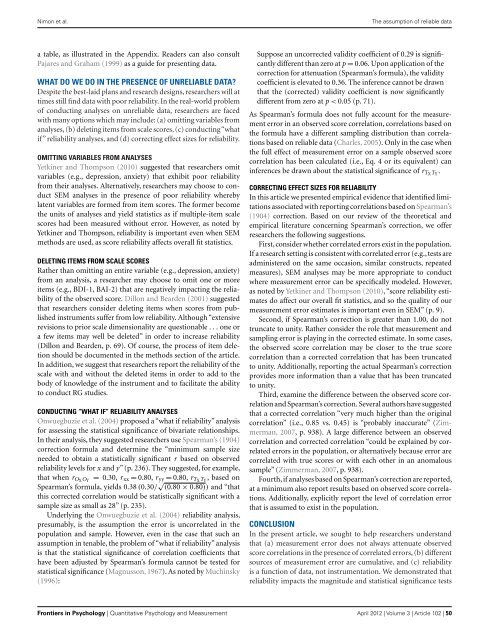Sweating the Small Stuff: Does data cleaning and testing ... - Frontiers
Sweating the Small Stuff: Does data cleaning and testing ... - Frontiers
Sweating the Small Stuff: Does data cleaning and testing ... - Frontiers
- No tags were found...
Create successful ePaper yourself
Turn your PDF publications into a flip-book with our unique Google optimized e-Paper software.
Nimon et al.The assumption of reliable <strong>data</strong>a table, as illustrated in <strong>the</strong> Appendix. Readers can also consultPajares <strong>and</strong> Graham (1999) as a guide for presenting <strong>data</strong>.WHAT DO WE DO IN THE PRESENCE OF UNRELIABLE DATA?Despite <strong>the</strong> best-laid plans <strong>and</strong> research designs, researchers will attimes still find <strong>data</strong> with poor reliability. In <strong>the</strong> real-world problemof conducting analyses on unreliable <strong>data</strong>, researchers are facedwith many options which may include: (a) omitting variables fromanalyses, (b) deleting items from scale scores, (c) conducting“whatif” reliability analyses, <strong>and</strong> (d) correcting effect sizes for reliability.OMITTING VARIABLES FROM ANALYSESYetkiner <strong>and</strong> Thompson (2010) suggested that researchers omitvariables (e.g., depression, anxiety) that exhibit poor reliabilityfrom <strong>the</strong>ir analyses. Alternatively, researchers may choose to conductSEM analyses in <strong>the</strong> presence of poor reliability wherebylatent variables are formed from item scores. The former become<strong>the</strong> units of analyses <strong>and</strong> yield statistics as if multiple-item scalescores had been measured without error. However, as noted byYetkiner <strong>and</strong> Thompson, reliability is important even when SEMmethods are used, as score reliability affects overall fit statistics.DELETING ITEMS FROM SCALE SCORESRa<strong>the</strong>r than omitting an entire variable (e.g., depression, anxiety)from an analysis, a researcher may choose to omit one or moreitems (e.g., BDI-1, BAI-2) that are negatively impacting <strong>the</strong> reliabilityof <strong>the</strong> observed score. Dillon <strong>and</strong> Bearden (2001) suggestedthat researchers consider deleting items when scores from publishedinstruments suffer from low reliability. Although “extensiverevisions to prior scale dimensionality are questionable ...one ora few items may well be deleted” in order to increase reliability(Dillon <strong>and</strong> Bearden, p. 69). Of course, <strong>the</strong> process of item deletionshould be documented in <strong>the</strong> methods section of <strong>the</strong> article.In addition, we suggest that researchers report <strong>the</strong> reliability of <strong>the</strong>scale with <strong>and</strong> without <strong>the</strong> deleted items in order to add to <strong>the</strong>body of knowledge of <strong>the</strong> instrument <strong>and</strong> to facilitate <strong>the</strong> abilityto conduct RG studies.CONDUCTING “WHAT IF” RELIABILITY ANALYSESOnwuegbuzie et al. (2004) proposed a “what if reliability” analysisfor assessing <strong>the</strong> statistical significance of bivariate relationships.In <strong>the</strong>ir analysis, <strong>the</strong>y suggested researchers use Spearman’s (1904)correction formula <strong>and</strong> determine <strong>the</strong> “minimum sample sizeneeded to obtain a statistically significant r based on observedreliability levels for x <strong>and</strong> y” (p. 236). They suggested, for example,that when r OX O Y= 0.30, r xx = 0.80, r yy = 0.80, r TX T Y, based onSpearman’s formula, yields 0.38 (0.30/ √ (0.80 × 0.80)) <strong>and</strong> “thatthis corrected correlation would be statistically significant with asample size as small as 28” (p. 235).Underlying <strong>the</strong> Onwuegbuzie et al. (2004) reliability analysis,presumably, is <strong>the</strong> assumption <strong>the</strong> error is uncorrelated in <strong>the</strong>population <strong>and</strong> sample. However, even in <strong>the</strong> case that such anassumption in tenable, <strong>the</strong> problem of “what if reliability” analysisis that <strong>the</strong> statistical significance of correlation coefficients thathave been adjusted by Spearman’s formula cannot be tested forstatistical significance (Magnusson, 1967). As noted by Muchinsky(1996):Suppose an uncorrected validity coefficient of 0.29 is significantlydifferent than zero at p = 0.06. Upon application of <strong>the</strong>correction for attenuation (Spearman’s formula), <strong>the</strong> validitycoefficient is elevated to 0.36. The inference cannot be drawnthat <strong>the</strong> (corrected) validity coefficient is now significantlydifferent from zero at p < 0.05 (p. 71).As Spearman’s formula does not fully account for <strong>the</strong> measurementerror in an observed score correlation, correlations based on<strong>the</strong> formula have a different sampling distribution than correlationsbased on reliable <strong>data</strong> (Charles, 2005). Only in <strong>the</strong> case when<strong>the</strong> full effect of measurement error on a sample observed scorecorrelation has been calculated (i.e., Eq. 4 or its equivalent) caninferences be drawn about <strong>the</strong> statistical significance of r TX T Y.CORRECTING EFFECT SIZES FOR RELIABILITYIn this article we presented empirical evidence that identified limitationsassociated with reporting correlations based on Spearman’s(1904) correction. Based on our review of <strong>the</strong> <strong>the</strong>oretical <strong>and</strong>empirical literature concerning Spearman’s correction, we offerresearchers <strong>the</strong> following suggestions.First,consider whe<strong>the</strong>r correlated errors exist in <strong>the</strong> population.If a research setting is consistent with correlated error (e.g.,tests areadministered on <strong>the</strong> same occasion, similar constructs, repeatedmeasures), SEM analyses may be more appropriate to conductwhere measurement error can be specifically modeled. However,as noted by Yetkiner <strong>and</strong> Thompson (2010), “score reliability estimatesdo affect our overall fit statistics, <strong>and</strong> so <strong>the</strong> quality of ourmeasurement error estimates is important even in SEM” (p. 9).Second, if Spearman’s correction is greater than 1.00, do nottruncate to unity. Ra<strong>the</strong>r consider <strong>the</strong> role that measurement <strong>and</strong>sampling error is playing in <strong>the</strong> corrected estimate. In some cases,<strong>the</strong> observed score correlation may be closer to <strong>the</strong> true scorecorrelation than a corrected correlation that has been truncatedto unity. Additionally, reporting <strong>the</strong> actual Spearman’s correctionprovides more information than a value that has been truncatedto unity.Third, examine <strong>the</strong> difference between <strong>the</strong> observed score correlation<strong>and</strong> Spearman’s correction. Several authors have suggestedthat a corrected correlation “very much higher than <strong>the</strong> originalcorrelation” (i.e., 0.85 vs. 0.45) is “probably inaccurate” (Zimmerman,2007, p. 938). A large difference between an observedcorrelation <strong>and</strong> corrected correlation “could be explained by correlatederrors in <strong>the</strong> population, or alternatively because error arecorrelated with true scores or with each o<strong>the</strong>r in an anomaloussample” (Zimmerman, 2007, p. 938).Fourth,if analyses based on Spearman’s correction are reported,at a minimum also report results based on observed score correlations.Additionally, explicitly report <strong>the</strong> level of correlation errorthat is assumed to exist in <strong>the</strong> population.CONCLUSIONIn <strong>the</strong> present article, we sought to help researchers underst<strong>and</strong>that (a) measurement error does not always attenuate observedscore correlations in <strong>the</strong> presence of correlated errors, (b) differentsources of measurement error are cumulative, <strong>and</strong> (c) reliabilityis a function of <strong>data</strong>, not instrumentation. We demonstrated thatreliability impacts <strong>the</strong> magnitude <strong>and</strong> statistical significance tests<strong>Frontiers</strong> in Psychology | Quantitative Psychology <strong>and</strong> Measurement April 2012 | Volume 3 | Article 102 | 50














